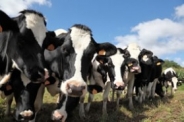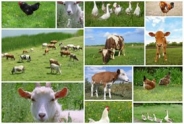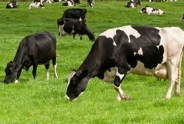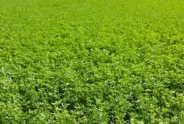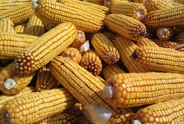Clean Milk Benefits People and Calves
Libby Eiholzer, Bilingual Dairy
Northwest New York Dairy, Livestock & Field Crops
June 5, 2013
Anyone who handles milk on the farm needs to take pains to keep it clean. Whether the milk will be sold for human consumption or fed to calves, it needs to be handled with the utmost care.
Why is this so important? Infections such as salmonella, mycoplasma and E. coli can be transmitted from cow to calf through manure as well as through milk, resulting in a very sick calf. Although milk sold commercially is always pasteurized for human consumption, milk cooperatives put a big emphasis on keeping it clean. Part of the quality bonus that farms can receive is based on milk testing below a certain level for bacteria counts.
So how do we keep it clean? First, by keeping the cow's environment clean: maintaining stalls free from manure and adequately bedded is a must, as well as regularly scraping alleys. Pre and post dipping teats during milking kills bacteria on the teats before milking and protects the teat opening after milking. It is also important to check the wash system in the parlor routinely to make sure that every surface that the milk touches, from the teat to the bulk tank, is being adequately disinfected. Utilizing these practices will help ensure the milk sold by the farm is high quality.
Cool the colostrum and milk fed to calves quickly to prevent bacteria growth- it only takes 30 minutes for the bacteria population to double in a pail of milk at room temperature! After feeding calves, wash all pails, bottles, nipples, etc. thoroughly using detergent, bleach and an acid rinse. All three must be used to avoid leaving a film of milk on the pail, which would create the perfect growing environment for bacteria. Let these tools air dry until the next feeding.
Clean Milk Leche Limpia
Clean the stalls and alleys Limpie las camas y los pasillos
Clean the teats Limpie los pezones
Put colostrum in the refrigerator Ponga el calostro en la refrigeradora
Wash the bottle Lave la botella
Let the pail air dry Deje que la cubeta se seque al aire
For more information on keeping colostrum clean, visit: calffacts
Leche Limpia Beneficia a la Gente y los Becerros
Todas las personas que tocan leche en la granja tienen que hacer lo necesario para mantenerla limpia. Si van a vender la leche por consumo humano o si la van a dar de comer a los becerros, hay que utilizar mucha precaucion.
¿Por qué es tan importante? Infecciones como la salmonela, la micoplasma y E. coli pueden ser transmitidos de la vaca al becerro tras el estiércol y también por la leche, lo que resulta en un becerro muy enfermo. Aunque siempre pasteurizan la leche vendida comercialmente para el consumo humano, las cooperativas ponen una énfasis muy fuerte en mantenerla limpia. Una parte del bono para la calidad que las granjas pueden recibir está basado en que la leche resulta con niveles de bacteria debajo de un cierto nivel.
¿Cómo la mantenemos limpia? Primero por mantener limpio el medioambiente de la vaca: mantener las camas libres de estiércol y con bastante aserrín o arena es necesario, igual que limpiar regularmente los pasillos. Pre y post sellar los pezones durante el ordeño mata las bacterias en los pezones antes de ordeñar y protege la punta del pezón después del ordeño. También es importante revisar regularmente el sistema de lavar en la sala de ordeña para estar seguro que cada superficie que toque la leche, desde la teta hasta el tanque, se está desinfectando adecuadamente. Utilizar estas prácticas puede ayudar a asegurar que la leche vendida por la granja es de alta calidad.
Enfríe rápidamente el calostro y leche que van a dar de comer a los becerros para prevenir el crecimiento de bacteria- ¡la población de bacteria en una cubeta de leche dobla en 30 minutos a temperatura ambiente! Después de alimentar a los becerros, lave todas las cubetas, botellas, pezones, etc. con detergente, cloro y un enjuague acido. Hay que usar los tres para prevenir que una capa de leche se forme en la cubeta, lo que sería el ambiente perfecto para el crecimiento de bacteria. Deje que se sequen al aire estas herramientas hasta usarlos en la próxima alimentación.
Para más información sobre cómo mantener limpio el calostro, vaya al sitio: calffacts
Upcoming Events
Western NY Value-Added Dairy Discussion Group: Jess May- Farm Credit East Webinar
May 2, 2024 : Value-Added Dairy Discussion Group Webinar: Jess May- Farm Credit East
Register here:
https://cornell.zoom.us/webina...
Western NY Value-Added Dairy Discussion Group: Eden Valley Creamery
May 3, 2024
South Dayton, NY
Registration for this discussion group is required and limited.
Western NY Value-Added Dairy Discussion Group: Shtayburne Farm Creamery
May 16, 2024
Rock Stream, NY
Registration for this discussion group is required and limited.
Announcements
Follow us on Instagram
See photos and reels of our most recent events and programs!Join us on Facebook!
Follow us on Facebook to get up to date posts about events, workshops and everything NWNY!Add us on LinkedIn!
Connect with us on LinkedIn to get more information about upcoming workshops and programs!

